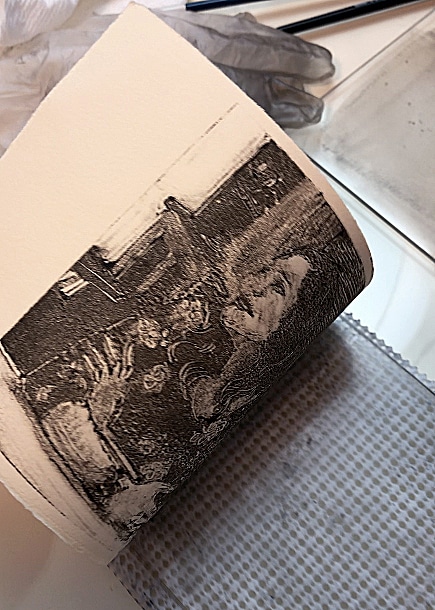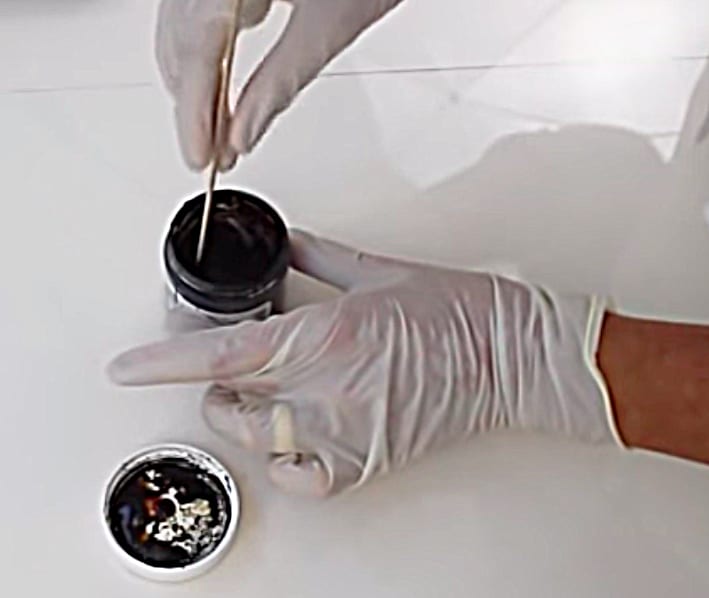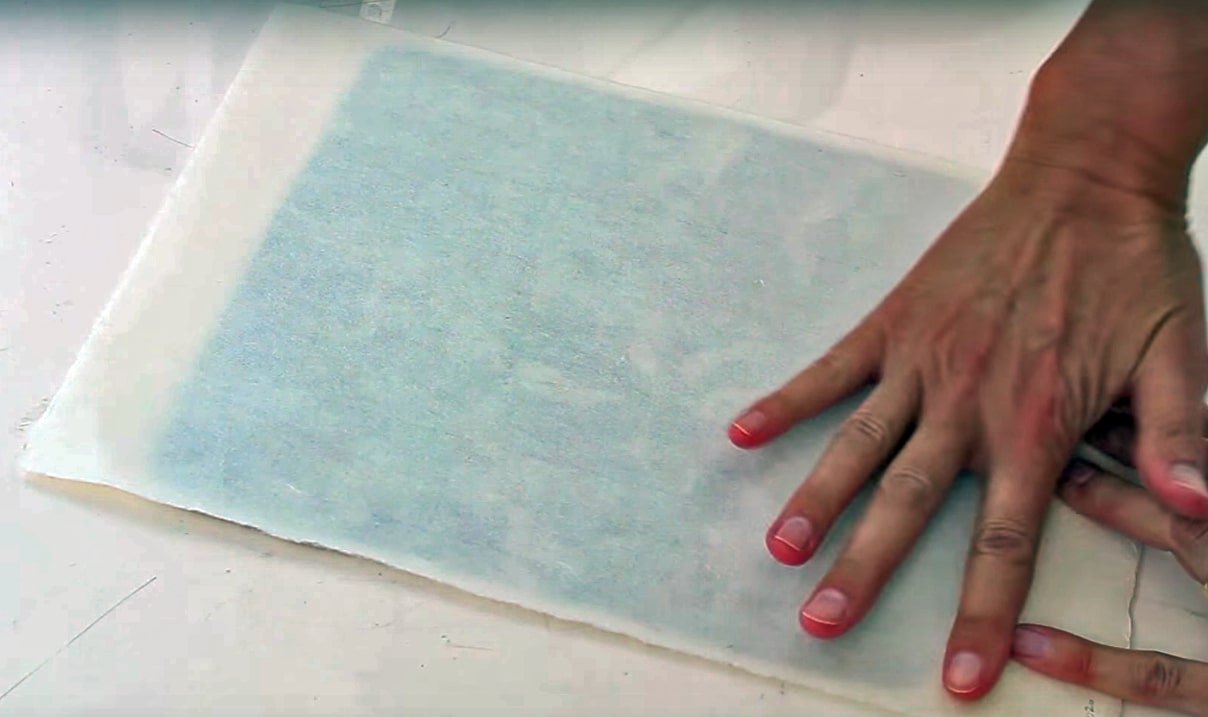Painterly Monotype Portraits with Colored Pencil
Painterly printmaking with monotype is a very accessible art project. You don’t need a press, or sharp tools, as there is no carving involved. Monotypes are simply pigments on a smooth plate, manipulated with tools into an image that is transferred to paper while the ink is still wet. Pressing a sheet of printmaking paper to the plate where the ink is arranged can be done with a cereal spoon, a baren, a wooden drawer pull, or even a fat marble.

Painterly Printmaking Monotype Supplies
I’ve been making painterly monotypes of one sort or another for 15 years, and they are still full of surprises. The fact that you can pull out a plate, roll some ink on it, and start carving light into the image with a pencil eraser always delights me. Monotype printmaking is quick and satisfying. And Magic too.
It’s not a fussy form of printmaking. There aren’t any harsh chemicals or solvents. You don’t need fancy tools. Monotypes can be printed in one color, or twenty. You can use printmaking ink, open (slow drying) acrylics, watercolors or water-soluble crayons and graphite.
If you don’t have a sheet of plexiglass, you can use a sheet of drafting film, or a report cover, or the underside of a melamine tray. You can pull a dozen prints in a day. And if you can’t draw, roll your ink in a sheer layer on something see-through so you can trace a photo slid underneath the plate.


Thought Provoking Essays
- Busy is the word we lean on a lot. When folks ask us how we’re doing, or what we’ve been up to, busy is grouted between the details. We use that word to explain why we can’t get to art-making. Being Busy is a foundational mindset, when we let it run the show. Read this article about the BS of Busy, and tell me what you think in the comments.
- Many of us are wondering how this Sheltering-In will be viewed by analysts in years to come. When the world is healthy again, and we’re each re-assembling our post-COVID19 mobility, what will we change after this Pause to Reflect? Has the time at home gifted us a chance at new perspective on what we really need in order to flourish and feel satisfied? This article has been making the rounds on the subject, and some of the points are excellent fodder for dinner table discussion.
- Time to #StayHome has also encouraged new routines. Lots of our friends are walking or doing yoga every day. Some are returning to art supplies after years of creative hiatus. This excellent essay by Crystal Moody tells the story of her commitment to make one little piece of art each day for a year, and how it grew into a four year practice that changed her life.

What is Your New Normal?
After weeks of staying home, and an uncertain timeline for What Comes Next, many folks are pondering the new normal we’re marinating in. Aside from the uncertainty, this is also a time to reflect. What have we lived without that we don’t really miss? Who feels the most important to stay connected with? What new habits have we started?
There are people walking in my neighborhood that I’ve never seen before. When we walk each day, every person coming down the opposite side of the street – whether they are in cars, or on foot/bicycle – keeps the advised distance, smiles, waves and says hello! That’s a first.
We’re cooking, eating and drinking more. Experimental recipes with recommended beverages have satisfied creative urges in the kitchen, and made use of pantry goods we wanted to consume. They’ve also provided delicious meals.
Baking Sourdough Bread
I’ve heard about yeast and flour shortages, since everyone is baking bread. (Our stores have no flour or yeast.) Folks are sharing sourdough starter and bread-baking tips. We were gifted a fresh loaf that we consumed in a day. So, we may begin summer a little snug under the belt, but I bet we’ve all enjoyed some tasty, pleasant evenings around the dinner table, no?
Every Tuesday night, we have a happy hour chat on Zoom (a free video conferencing app) with our family. Despite time changes and wobbly schedules, we’ve enjoyed adult beverages among a grid of familiar faces on the computer monitor, catching up, and laughing together. Are you using video conferencing with your friends and family too?
If the stars should appear but one night every thousand years how man would marvel and adore…
Ralph Waldo Emerson

Evolution Towards Better
This situation reminds us of a very important truth: We are incredibly adaptable. Our skills at adjusting radiate in an increasing arc – as an individual, in a family, within a community, as part of a state, inside a nation, and beyond. We always find our way. (Remind yourself of that, over and over again.) The first week is hard, and the next is a little easier. We build up towards this new stride. (Read this article about our adaptability.)
I hope your hard days are bookended by homemade desserts. With time, I hope we all succeed in rearranging the blocks on our schedules to suit our most sought after endeavors.
Thanks for your visit, and I’ll see you in the next post!
Belinda
The Price of anything is the amount of life you exchange for it.
Henry David Thoreau

Monotype Examples






Here are a few more examples (above) of monotypes with watercolor and/or colored pencil added. You can also see a list of supplies and more details on how to make a monotype below.
Art Quote
I love William Blake…. William Blake said, “If he who is organized by the divine for spiritual communion, refuse and bury his talent in the earth, even though he should want natural bread, shame and confusion of face will pursue him throughout life to eternity.” He’s telling you that you’ll be miserable if you don’t do what you’re supposed to do.
Kris Kristofferson


How to Make a Monotype Print
If you've ever wondered how to make a dark field monotype print, you've come to the right place! Here are step by step monotype process photos, videos, and a supply list with links to the items you'll need to get started.
You don't need a press, or any fancy printmaking equipment.
And if you learn best by watching a demonstration, here is a list of monotyping tutorial videos that cover dark field and light field monotype, as well as trace monotype printmaking demos.
With a little space cleared on a kitchen table, a few supplies, and some reference photos, you'll be making monotype prints in no time at all! Happy Printing!
Materials
Tools
Instructions
- Prepare a flat, clear surface to work on by covering it with newspapers. Gather all supplies close at hand, and put on your apron and rubber gloves.

- Tape down your ink slab.

- Stir your printmaking ink until it's smooth and mixed well. Put a dollop of ink on the slab about the size of a cashew nut.

- Use your brayer to roll the ink out on the slab until it's evenly covering the brayer, and the slab, and you hear the ink "hiss" as you roll back and forth

- Put a piece of non skid under your plexiglass printmaking plate (not necessary if you're printing from a gelli plate) and begin coating your plexiglass with a smooth, even coat of ink

- When the plate is completely covered, if the ink appears loose, shiny or thick, lay a piece of newsprint on the plate, and very gently, with light pressure, smooth it with your hand as though you were smoothing a wrinkle from a bed sheet

- Peel the newsprint from the inked plate and discard it. Now that your ink has been blotted, it should be less shiny, and a bit thinner on the plate.

- Pull out a reference photo, and without touching the inked plate with your hand, begin drawing into the ink with your rubber tipped tool, and cotton swabs.

- If you need to rest your wrist while drawing, slide your drawing bridge over your ink plate so you can rest your hand on it above the ink.

- Use your brushes or your gloved finger tip, or rolled paper towel, or cotton swabs to feather halftones in your design. You can also use them to add more ink by dipping in the ink slab and adding darks to your design.

- When your design is ready to print, pull a sheet of printmaking paper from the package or pad, and with your spray bottle, lightly spritz the side you'll be printing on. Blot with a paper towel, and lay the damp side down on your inked and designed monotype.

- Hold the paper steady with one hand, while rubbing the back of the paper with either the baren or a metal spoon.

- Keep the paper in place with a firm hand, and peel up a corner to see how your ink is transferring to the paper. If it looks too light, or mottled, apply more pressure with the spoon in circular motions.

- When you feel like you've transferred enough ink from the plate to the paper, pull your print, and take delight in your beautiful monotype.

- After the ink is dry, feel free to add color to the print with colored pencil, pastels, or watercolor (provided you didn't use re-wetting ink, like Speedball).

Notes
If you make a mistake on a portion of your plate while you're designing and clearing ink, re-roll your ink, and re-blot if necessary. The inks (if you're using akua) stay wet for a very long time, until they are pressed to paper, so take your time, and get the hang of this painterly printmaking process.


Hola Belinda! Te escribo desde Argentina , gracias por tantas ideas! Me son de muchísima utilidad. Beso enorme
Hola VZ, ¡Gracias por tu nota! ¡Me alegra que las ideas aquí sean útiles, y espero que te diviertas mucho en Argentina con ellas!
Hello Belinda, thank you so much for this lesson, enjoyed it so much. I am in isolation in Hobart Tasmania in Australia. Keep safe 👍
Hello Audrey, Thanks for your visit and the reach-out from so far away. I hope your Stay-Home time includes some creative experiments and art-making. Stay safe, and healthy – and keep in touch. 🤝
Wonderful Post, Thank you! Monotypes are perfect to do after sorting out so much I can see 90% of my craft table.
The links are also fantastic! Gambuto’s article is must reading. The Friday Focus article…a light went off brightly when I read, “I’m been focusing on the wrong things.”
Stay well & Safe!
Hi there, Maywyn! I’m glad the monotype instructions arrived just in time to occupy your recently cleared table space! If you make some, please come back and share a link where we can see them! And lots of head-nodding here on your reaction to the essays. Good thought food, for sure! Happy art-making!